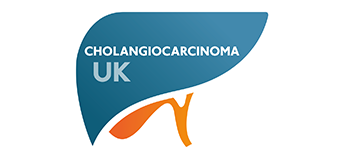Diagnosis and Staging
Cholangiocarcinoma Symptoms
For information on the symptoms of cholangiocarcinoma, click here.
How Cholangiocarcinoma may be diagnosed
A GP’s examination and blood tests will be followed by referral to a hospital for specialist tests, expert advice and treatment.
As well as general health tests, including checking liver function, the following tests are which may be used to diagnose Cholangiocarcinoma:
- Ultrasound scan
- CT (computerised tomography) scan
- MRI (magnetic resonance imaging)
- ERCP (endoscopic retrograde cholangiopancreatography)
- EUS (endoscopic ultrasound scan)
- PTC (percutaneous transhepatic cholangiography)
- PET (positron emission tomography)
- Angiogram
- Biopsy
- Laparoscopy
Ultrasound scan
This test uses sound waves to build-up a picture of the bile ducts and surrounding organs. The test is painless and takes 15-20 minutes.
CT (computerised tomography) scan
A CT scan takes a series of x-rays which build up a three-dimensional picture of the inside of the body. Usually a drink or injection is given before the scan to allow particular areas to be seen more clearly. The scan is painless and takes from 10-30 minutes.
MRI (magnetic resonance imaging)
This test is similar to a CT scan, but uses magnetic fields instead of x-rays and takes place with the patient lying on a couch inside a metal cylinder. Read More
ERCP (endoscopic retrograde cholangiopancreatography)
This procedure may be used to take an x-ray image of the pancreatic duct and bile duct. It can also be used to unblock the bile duct if necessary. Read More
EUS (endoscopic ultrasound scan)
This scan is similar to an ERCP but involves an ultrasound probe being passed down the endoscope to take an ultrasound scan of the pancreas and surrounding structures.
PTC (percutaneous transhepatic cholangiography)
This procedure may be used to take an x-ray picture of the bile duct. It may also be used to take a biopsy (get a sample of tissue) from the tumour. Read More
PET (positron emission tomography)
A PET scan is a special kind of imaging test which allows doctors to see how certain tissues and organs within the body are functioning. Read More
Angiogram
This is a test to look at blood vessels. The bile duct is very close to large blood vessels that carry blood to and from the liver. An angiogram may be used to check whether any of them are affected by the cancer. Read More
Biopsy
The results of the previous tests may strongly suggest a diagnosis of cholangiocarcinoma, but often the only way to be sure of this is a biopsy. Read More
Laparoscopy
A laparoscopy is sometimes used to help diagnose cholangiocarcinoma and is carried out under a general anaesthetic. Read More
Staging
The stage of a cancer is a term used to describe its size and whether it has spread beyond its original site. Knowing the stage of a cancer helps doctors to decide on the most appropriate treatment.
Cancer can spread in the body in the blood stream or through the lymphatic system. The lymphatic system is part of the body’s defence against infection and disease. It is made up of a network of lymph nodes connected by fine tubes.
By examining the lymph nodes close to the biliary system the stage of the cholangiocarcinoma can be assessed.
TNM Staging for cholangiocarcinoma (bile duct cancer)
TNM stands for Tumour, Node and Metastasis.
T describes the size of the primary tumour
N describes whether the cancer has spread to the lymph nodes
M describes whether the cancer has spread to a different area of the body
Each type of cholangiocarcinoma1 – intrahepatic, hilar (or perihilar), extrahepatic/distal – is individually listed under the TNM staging system. Read More
Grading
Grading refers to the appearance of the cancer cells under the microscope and gives an idea of how quickly the cancer may develop.
Low-grade means that the cancer cells look very like normal cells; they are usually slow-growing and are less likely to spread. In high-grade tumours the cells look very abnormal, are likely to grow more quickly and are more likely to spread.







